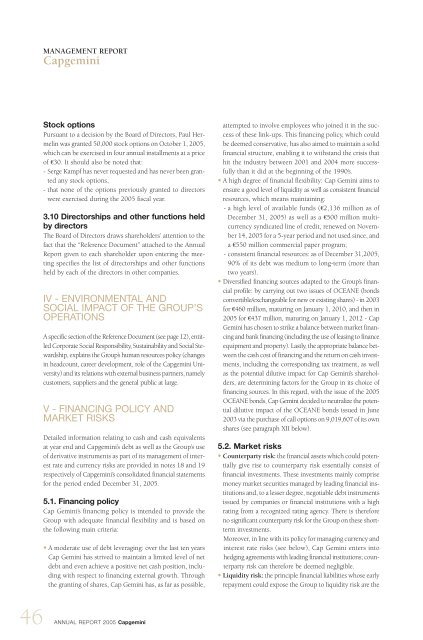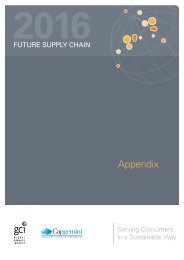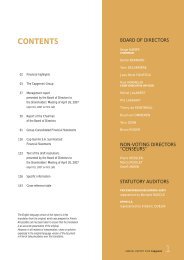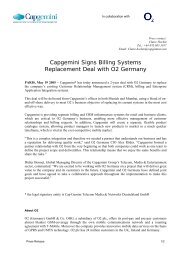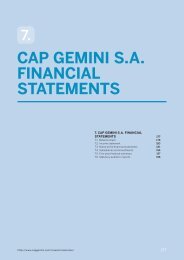Create successful ePaper yourself
Turn your PDF publications into a flip-book with our unique Google optimized e-Paper software.
46 ANNUAL<br />
MANAGEMENT REPORT<br />
<strong>Capgemini</strong><br />
Stock options<br />
Pursuant to a decision by the Board of Directors, Paul Hermelin<br />
was granted 50,000 stock options on October 1, <strong>2005</strong>,<br />
which can be exercised in four annual installments at a price<br />
of €30. It should also be noted that:<br />
- Serge Kampf has never requested and has never been granted<br />
any stock options,<br />
- that none of the options previously granted to directors<br />
were exercised during the <strong>2005</strong> fiscal year.<br />
3.10 Directorships and other functions held<br />
by directors<br />
The Board of Directors draws shareholders’ attention to the<br />
fact that the “Reference Document” attached to the Annual<br />
<strong>Report</strong> given to each shareholder upon entering the meeting<br />
specifies the list of directorships and other functions<br />
held by each of the directors in other companies.<br />
IV - ENVIRONMENTAL AND<br />
SOCIAL IMPACT OF THE GROUP’S<br />
OPERATIONS<br />
A specific section of the Reference Document (see page 12), entitled<br />
Corporate Social Responsibility, Sustainability and Social Stewardship,<br />
explains the Group’s human resources policy (changes<br />
in headcount, career development, role of the <strong>Capgemini</strong> University)<br />
and its relations with external business partners, namely<br />
customers, suppliers and the general public at large.<br />
V - FINANCING POLICY AND<br />
MARKET RISKS<br />
Detailed information relating to cash and cash equivalents<br />
at year end and <strong>Capgemini</strong>’s debt as well as the Group’s use<br />
of derivative instruments as part of its management of interest<br />
rate and currency risks are provided in notes 18 and 19<br />
respectively of <strong>Capgemini</strong>’s consolidated financial statements<br />
for the period ended December 31, <strong>2005</strong>.<br />
5.1. Financing policy<br />
Cap Gemini’s financing policy is intended to provide the<br />
Group with adequate financial flexibility and is based on<br />
the following main criteria:<br />
• A moderate use of debt leveraging: over the last ten years<br />
Cap Gemini has strived to maintain a limited level of net<br />
debt and even achieve a positive net cash position, including<br />
with respect to financing external growth. Through<br />
the granting of shares, Cap Gemini has, as far as possible,<br />
REPORT <strong>2005</strong> <strong>Capgemini</strong><br />
attempted to involve employees who joined it in the success<br />
of these link-ups. This financing policy, which could<br />
be deemed conservative, has also aimed to maintain a solid<br />
financial structure, enabling it to withstand the crisis that<br />
hit the industry between 2001 and 2004 more successfully<br />
than it did at the beginning of the 1990’s.<br />
• A high degree of financial flexibility: Cap Gemini aims to<br />
ensure a good level of liquidity as well as consistent financial<br />
resources, which means maintaining:<br />
- a high level of available funds (€2,136 million as of<br />
December 31, <strong>2005</strong>) as well as a €500 million multicurrency<br />
syndicated line of credit, renewed on November<br />
14, <strong>2005</strong> for a 5-year period and not used since, and<br />
a €550 million commercial paper program;<br />
- consistent financial resources: as of December 31,<strong>2005</strong>,<br />
90% of its debt was medium to long-term (more than<br />
two years).<br />
• Diversified financing sources adapted to the Group’s financial<br />
profile: by carrying out two issues of OCEANE (bonds<br />
convertible/exchangeable for new or existing shares) - in 2003<br />
for €460 million, maturing on January 1, 2010, and then in<br />
<strong>2005</strong> for €437 million, maturing on January 1, 2012 - Cap<br />
Gemini has chosen to strike a balance between market financing<br />
and bank financing (including the use of leasing to finance<br />
equipment and property). Lastly, the appropriate balance between<br />
the cash cost of financing and the return on cash investments,<br />
including the corresponding tax treatment, as well<br />
as the potential dilutive impact for Cap Gemini’s shareholders,<br />
are determining factors for the Group in its choice of<br />
financing sources. In this regard, with the issue of the <strong>2005</strong><br />
OCEANE bonds, Cap Gemini decided to neutralize the potential<br />
dilutive impact of the OCEANE bonds issued in June<br />
2003 via the purchase of call options on 9,019,607 of its own<br />
shares (see paragraph XII below).<br />
5.2. Market risks<br />
• Counterparty risk: the financial assets which could potentially<br />
give rise to counterparty risk essentially consist of<br />
financial investments. These investments mainly comprise<br />
money market securities managed by leading financial institutions<br />
and, to a lesser degree, negotiable debt instruments<br />
issued by companies or financial institutions with a high<br />
rating from a recognized rating agency. There is therefore<br />
no significant counterparty risk for the Group on these shortterm<br />
investments.<br />
Moreover, in line with its policy for managing currency and<br />
interest rate risks (see below), Cap Gemini enters into<br />
hedging agreements with leading financial institutions; counterparty<br />
risk can therefore be deemed negligible.<br />
• Liquidity risk: the principle financial liabilities whose early<br />
repayment could expose the Group to liquidity risk are the


